
The image above is the wrapper for an old spool of gimp, "vergolina" being the Italian word for gimp, and La Milanese being the brand name. I am guessing that this is how the French came to know gimp as "Milanaise", and thus the Milanese buttonhole would have found its name. Conjecture, but likely.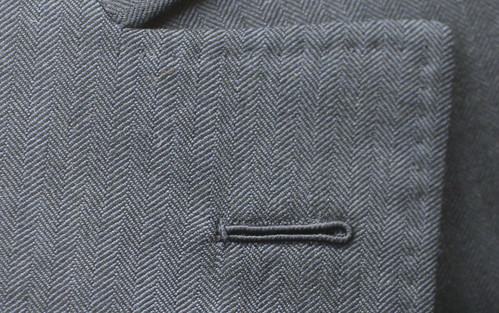
I've discussed this buttonhole a few times, mainly because I didn't know how to do it and that was driving me crazy. The example above is from a coat by Smalto and I had a good look under a magnifying glass and finally figured that stitch out- it is a fairly simple figure-of-eight stitch with no knot or purl. More on that soon. A reader was kind enough to reach out with another method of making them.
Matthew Reed did the CAP Tailleur Homme in Paris (a training program in tailoring) and did his internship at Cifonelli, a famous Parisian house. (If you read French you can find a recent interview with Lorenzo Cifonelli here) Matthew was kind enough to photograph a high-contrast buttonhole sample that he learned at Cifonelli, and the steps involved in making it- you will notice that in this version there is a knot underneath the gimp, which I rather like because it raises the buttonhole higher off the surface and makes it a bit more pronounced (subtletly be damned). So thank you, Matthew.
The gimp has been knotted and inserted between the layers of cloth- it must be lifted out of the way when taking the stitch.
Wrap the tail of the twist around the head of the needle.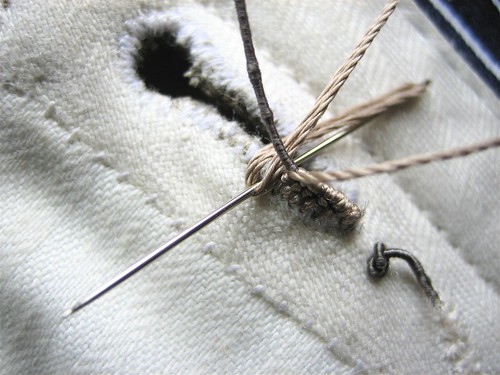
Pull through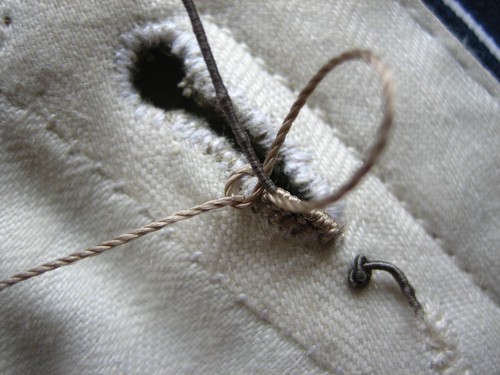
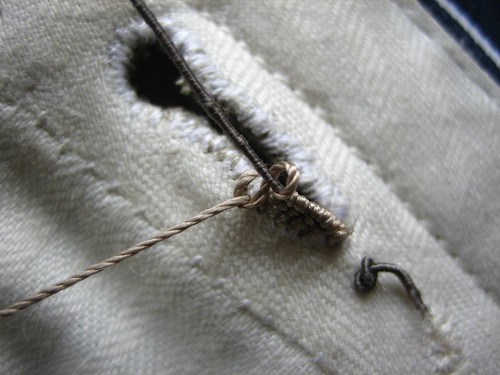

Pull tight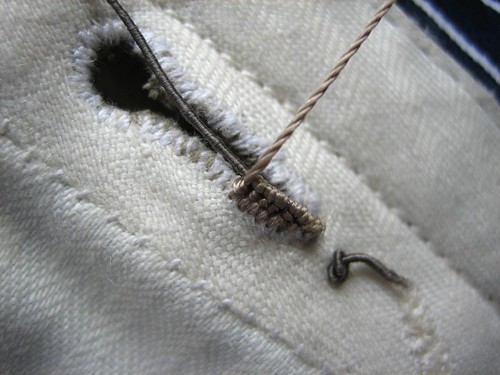
I've been mumbling about buying a macro lense since my close-ups leave much to be desired, but seeing Matthew's photos I'm leaning toward a point-and-shoot instead, which would be cheaper and more versatile. So double inspiration, thanks to Matthew.
EDIT-
Franca made some interesting observations in the comments section. She has discovered what many have found, namely that many old tailors guard their secrets jealously... She compares the buttonhole above to the buttonholes she sees in her region (Abruzzo) but the buttonhole above has a knot, and the ones made in Abruzzo, particularly Brioni, do not have a knot- it is slightly simpler in certain respects, but require more precision. She has discovered that cloth that frays easily is not suitable, or at least will be difficult to make a stitch that is small enough even though she has overcast before stitching. I will suggest running a machine stitch 1/16" away from the cut location on each side (before cutting) which will help stabilize the area. As for the stitch itself, once I get my macro photography sorted out I will post a series of photos like the ones Matthew submitted, showing the Asola Lucida, al modo di Brioni. And yes, Franca, the only thing to do is to practice and practice some more.








17 comments:
Excellent work! Thank you!!
Interesting how the Cifonelli method contrasts with the Brioni; the Brioni buttonhole was pretty flat whereas these are raised above the surface. I'm guessing there's more than one way of doing this?
Did you hand sew the buttonhole with white thread beforehand? Sorry, I am a newbie
@Benjamin- yes- was my post not clear?
@Sewing Princess- while it would be common to overcast the buttonhole by hand before working it in silk, it is possible that Matthew had stitched it by machine first. A number of factories and tailors do this now.
how do you finished it? to loos like the "bar tack" at the end is raised even higher? thanks
and how long does it take to make that beautiful buttonhole?
now this i've got to try. and what carl said.
thank you mr d.
The post was clear; I meant to say more ways of doing it than the ones outlined in the post. The Brioni buttonhole looks VERY flat, almost like very tight overcasting. It doesn't look like it was made with the figure 8 and certainly not the Cifonelli raised and knotted stitch. When you unpicked the Brioni's hole (in the Samuelsohn and Brioni DJ comparison), was it a figure 8 stitch or something else?
Don't thank me, thank Matthew, who I hope will drop by to answer questions.
@Benjamin- the Brioni was ages ago so I don't really recall, but I think it was the figure-eight stitch (certainly the Smalto and Tom Ford were done this way) but using a very fine thread so it just looks like satin. I'm looking into the thread they use at the Zegna factory that makes the TF stuff.
great post and blogs
as for camera i would strongly recommend lx 4 panasonic
has great macro and fast lens so you wont be needing flash at all
Thanks Jeffrey. Really appreciate you putting this up.
@Zoran- thanks for the recommendation.
@Anonymous. Again, don't thank me, thank Matthew. Everybody repeat after me- "Thank you, Matthew". Lol.
Hello everyone, and you Jeffery, I am Franca. I tried to do the "asola lucida", as you've described, but I noticed that in the thin fabric is not as beautiful as your. It is not see only the "vergolina" covered with silk, but also the points are evident. While in the your butthonhole only see the gimp covered with the silk. Have I done something wrong?
P.S. I hope I have written all good
FRANCA FROM ITALY
@Franca- you will notice a small purl underneath the gimp (vergolina), however it is possible that you are taking stitches that are too wide- they must be just a hair wider than the thickness of the gimp itself so that they will be covered.
P.S. You wrote just fine, but if you are unsure of your English, you could also write in Italian and I will understand.
Thanks for your answer, Jeffery
ok I'll write in Italian and I hope you understand me.
Ho sempre realizzato capospalla con l'asola occhiello con vergolina. Nella mia regione (Abruzzo) ci sono molti sarti, alcuni lavorano anche alla Brioni Roman Style di Penne, infatti uno di loro, con cui ho frequentato l’istituto di moda, MOLTI anni fa, mi insegnò a ricamare l’asola occhiello.
Qualche tempo fa ho chiesto ad un sarto della mia città se mi faceva vedere “l'asola lucida” da fare sul rever, ma ha trovato delle scuse e mi ha detto che era impegnato…….! Quando ho visto le tue foto sul tuo blog sono stata molto felice, ed ho cominciato a provare e riprovare.
Il bello della tua “asola lucida” è che c’è il punto asola sotto la vergolina, mentre alla Brioni la fanno senza nodino, girando il filo di seta intorno alla vergolina e facendo un punto semplice.
Per quanto riguarda il mio problema, ho provato a fare un punto più piccolo per evitare che si vedesse sotto il cordoncino, ma il tessuto che sto usando è sottile e si sfilaccia moltissimo, anche se ho fatto il sorfilo a mano con filo di poliestere sottile.
MA NON MI ARRENDO!!!! Proverò e riprOverò finché verrà perfetta!! Grazieeee!!! Thank you very much!!
Congratulations for your blog! It 's wonderful!
Good day to you all
Franca
@Franca- ti capisco perfettamente! Vedi sopra per il risposto.
Thank you Jeffrey, I read everything. See you soon.
Franca
That is the nicest buttonhole I have seen so far. I was only thought to make simple buttonhole without gimp, and I don't like them to much as they are to flat. I will change to that button hole now. In Germany they made gimp button holes in the 30thies with hand silk not with button hole silk, they also look good.
Post a Comment